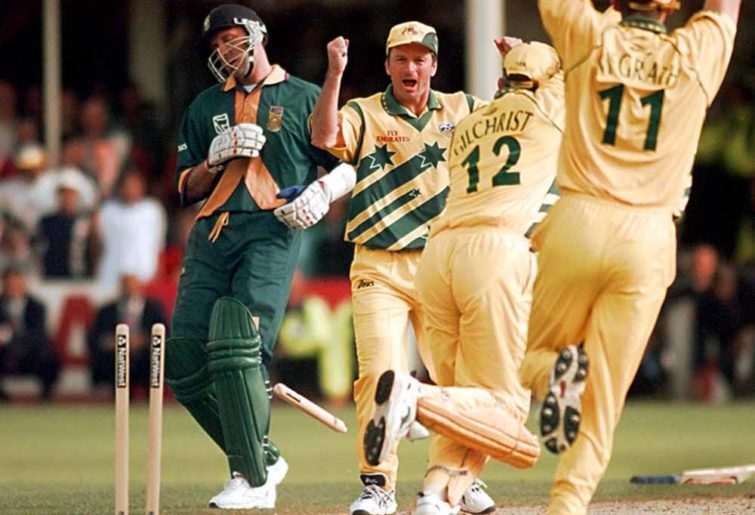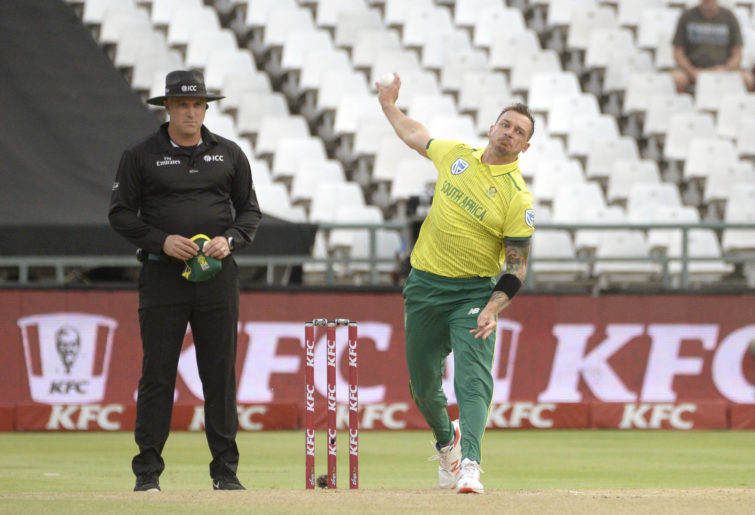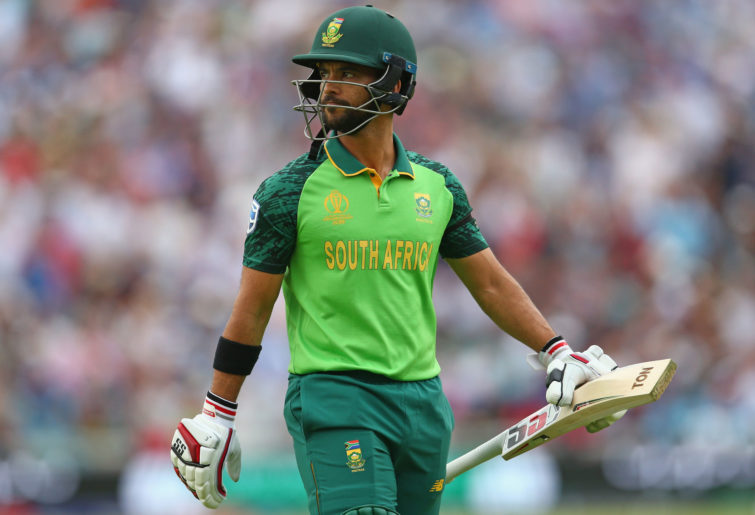“It’s a little bit embarrassing.”
Those were the words uttered by South African skipper, Faf du Plessis after his side lost by 49 runs to Pakistan at Lord’s.
That result saw the life support system on the Proteas’ World Cup campaign switched off.
The South African team has won just one of its seven matches.
Only Afghanistan sits below them on the table.
Their last two games will have no impact on their future as they are heading home early regardless.
Alas, for South African fans, failure at the World Cup is something they are used to.
Since re-entering the international arena post-Apartheid, the country has contested eight World Cups.
They have made the semi-finals four times, only to be denied a finals berth on each occasion.
Along the way the most unwanted sobriquet in sport – ‘chokers’ – has been applied at various times.

One of South Africa’s most famous World Cup capitulations. (AP Photo/Rui Vieira)
None more so than 2003, when South Africa hosted the tournament.
A fourth-place finish in their pool saw them miss out on the super six stage.
This time around, the current team was seen as a legitimate semi-final prospect.
Most saw England, India and Australia filling three of the four slots in the semis with New Zealand and South Africa the most favoured to make up the final four.
As it has turned out, the Black Caps are currently sitting atop the tree with five wins from six starts.
In a bid to end their World Cup drought, Cricket South Africa produced what it called ‘Vision 2019’, a concerted effort to produce a team with the ability and wherewithal to lift the silverware.
A major snag was hit in May 2018 when the side’s talisman, A B de Villiers made the shock announcement that he was retiring from all forms of international cricket, effective immediately.
It was expected that he would pull the pin on his Proteas career after the World Cup having said numerous times in the previous few years that winning the trophy was his ultimate aim.
Bizarrely, on the day that South Africa finalised its squad for this year’s tournament, de Villiers approached the captain and coach and said he wished to make a comeback.
The skipper reportedly was keen to have de Villiers back but the selectors thought otherwise.
News of his plans to abandon his international retirement at the eleventh hour became public after South Africa had lost its opening three matches of the tournament.
It provided a substantial distraction to a team that was firmly under the pump.
The selectors did take a risk, however, with the selections of pacemen Dale Steyn and Lungi Ngidi.
Both were sidelined with injury in the lead-in to the tournament.
While Steyn has been a great of the game, he has barely donned the coloured uniform in recent years.

South Africa’s Dale Steyn bowls (Photo by RODGER BOSCH / AFP)
Since January 2016, he has played just 13 one-day internationals.
Not surprisingly, he was withdrawn from the squad with his ongoing shoulder problem before he could bowl a single delivery.
Ngidi, who was suffering a side strain in the build-up, has missed three games with a hamstring injury.
For much of the tournament, quick Kagiso Rabada and 40-year-old leg-spinner Imran Tahir have been required to shoulder the bulk of the load.
Both have toiled manfully and done their best to keep their side in games.
But it is the batting that has been particularly lacklustre.
Quinton de Kock is the leading run-scorer with 238 runs from seven innings at 39.7, considerably down on his career average of 45.2.
His strike rate has been a rather pedestrian 84 against a career mark of 95.
His 68 against Afghanistan is the highest of his team’s seven half-centuries.
Hashim Amla has had a woeful tournament.
His six innings have netted 123 runs at 24.6 with a strike rate of 59.
Compared to his career average and strike rate of 49.0 and 89 respectively it underlines his fall from grace.
His last 22 ODIs have produced a meagre average of 32.6.
He has been kept in the side more on sentiment than performance.
At 36, this World Cup will surely be his last hurrah.
JP Duminy, at 35, is likely to follow him on the ride into the sunset.

JP Duminy of South Africa (Photo by Steve Bardens/Getty Images)
He has contributed 56 runs in three innings.
The captain may be a casualty of this campaign as well.
While du Plessis has stated that he wishes to bow out following the T20 World Cup in Australia next October, he may not be accorded that luxury.
Throughout the tournament, South Africa has appeared to be tentative, almost afraid to take risks.
There has been a distinct lack of flair with the willow.
This is not the way the modern game is played.
They have played a brand of cricket more akin to the way the game was played a decade ago before T20 reinvigorated the one-day game and brought to it a more expansive 360-degree approach.
With every loss, the collective body language has appeared more and more fraught.
The pressure of expectation from a desperate supporter base appears to have ground them down.
South Africa will face a significant rebuild following this World Cup.
Successive sides have carried healthy expectations to the sports premier white ball tournament, often far greater than this time around.
Each time they have fallen short.
They have four years to get it right ahead of the next World Cup in India.
History indicates that it will be a monumental task.































































































